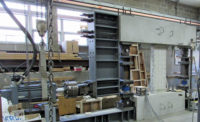Trailblazers seeking a faster, safer and less costly way to build concrete shear walls in seismic-zone high-rises have pioneered the use of steel fibers as link-beam reinforcing-steel "decongestants." Having smoothed the path and proven the concept on a limited basis in a 24-story tower in Seattle, the builders of The Martin Apartments say they are eager to use the approach on a broader scale.
"This unties the Gordian knot in seismic link beams, which have [bedeviled] contractors for years," says Cary Kopczynski, the force behind the rebar decongestants and president of the Bellevue, Wash.-based structural engineer that bears his name.
"I would absolutely sign up for it again," says Brian Foster, The Martin's project superintendent in the Seattle office of Exxel Pacific General Contractors. "It is a labor and time saver" if used from the outset of a job, he says.
Seismic link beams, which span shear-wall openings, are especially challenging to build. In addition to horizontal rebar with ties and stirrups, the prescriptive seismic code requires heavy X-shaped bars—the Gordian knot—that are difficult to insert because they often collide with the horizontal bars.
Batch-plant-mixed steel-fiber-reinforced concrete (SFRC), which is ductile and strong, cuts link-beam rebar by about 40%. The approach eliminates diagonal bars and reduces the size of the flexural and shear bars that remain, says Kopczynski, who has been trying to use SFRC beams for a decade.
The Martin, topped out in December, has five link beams per level. For the first installation, Kopczynski chose fibrous concrete for the two most challenging beams—those near the core's corners—which have the heaviest diagonals and are the toughest to install. "We wanted to walk before we ran," he says.
In the future, Kopczynski envisions SFRC applications beyond seismic link beams, including ductile moment-resisting frames with highly reinforced beams and columns. Soon, concrete with fiber, like adobe with straw, will be a homogenous material, he says.
The Martin's SFRC cost about $800 a cubic yard—about 10 times more than conventional concrete. "All stakeholders entered into the project cautiously, and pricing reflected that," says Kopczynski.
Foster agrees, saying the true cost of SFRC is about $350 per cu yd.
The local developer had the entire building permitted conventionally, in case the novel SFRC system did not gain city approval. "This was done as a change order," says Andrew Clapham, senior director of design and construction for Vulcan Inc. "When you can get competitive bidding, the price will go down."
To reduce costs and ease the process, Kopczynski plans to spearhead additional performance testing using fiber from many suppliers. "Marketplace competition combined with reductions in fiber dosage will allow future projects to realize significant cost and schedule savings," predicts the engineer.












Post a comment to this article
Report Abusive Comment